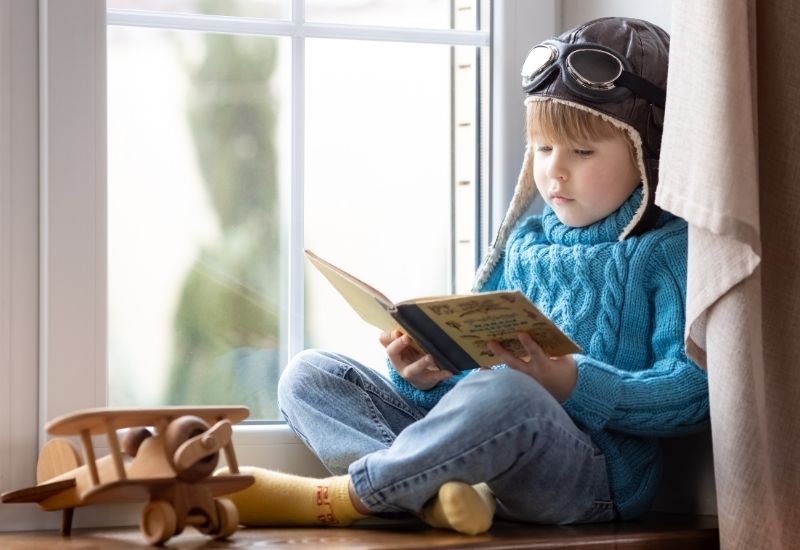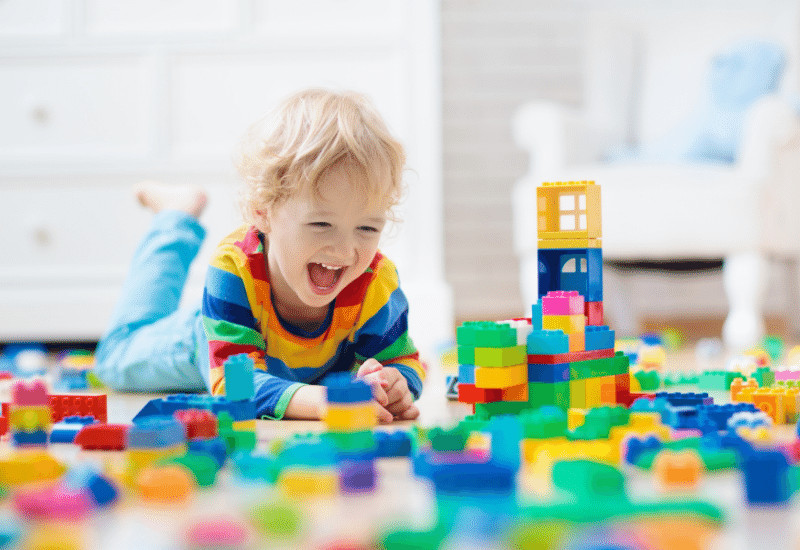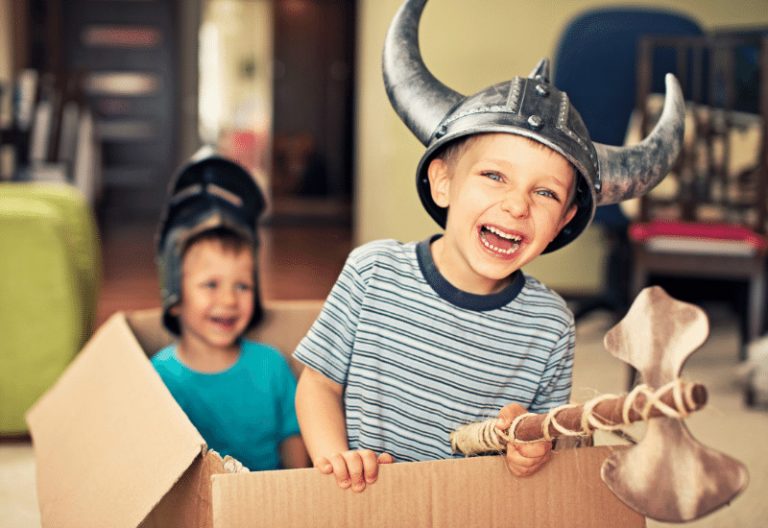How to encourage independent play – the simple and easy way!

Imagine this: You are on the couch. Enjoying your coffee and a good book without interruption, because your child is playing by himself.
This is no dream. It’s totally possible if you teach your child independent play.
I know, because I do it (like every other parent in Scandinavia). Theo can engage in independent play for hours, under the right circumstances, and he loves it.
So how to encourage independent play?
I’m going to help you with that!
I’m sharing with you my tips on solo play and the steps I’ve used to encourage independent play in my own children. You can teach your children to do this, too.
If you’re new to independent play, you can learn why you should get started in the first place here.
This post contains referral links for products I love. Danish Mom earns a small commission at no extra cost to you if you make a purchase through my links. Thank you for your support ♡
Table of Contents
What is independent play?
Independent play is when your child plays on its own without adults interfering. They play just to play – not to learn anything specific.
Solo play gives your child time and room to explore, discover, invent, and imagine. You can provide them with open-ended toys like building blocks or an easel, but it’s up to them to explore its possibilities.
Why independent play matters (benefits for your child)
In independent play, our little ones are granted the time and the opportunity to develop their coordination skills, problem-solving skills, and imagination.
Hand-eye coordination, problem-solving, building and invention, discovery and exploration — all of these are skills that can be nurtured by independent play.
Discover the MANY benefits of independent play and how it improves cognitive skills and physical health, including stress.

Today, most parents constantly stimulate their children
I grew up playing on my own, with my brothers, friends, and neighbors. My parents rarely entertained or played with us. We had lots of family hygge where we spent time together as a family. But we more or less played by ourselves the rest of the time.
And you know what?
We had fun!
We played all sorts of pretend play and games. Like Mommy and Daddy. Cops and robbers. We played with dolls and cars, with Lego and bricks, played with sand, water, mud, leaves, and sticks.
We played treasure hunt and hide and seek in the dark. We built caves inside and outside in the bushes.
Sure, we got bored sometimes. But my mom and dad always made sure there were toys for us, and we spent a lot of time in our big yard with lots of trees and bushes – perfect for outdoor play.
Today, though, parents keep their kids constantly busy. I do it, too, compared to my own upbringing. Today’s parents play with their kids every day, give them stimulating activities, and enroll them in soccer and whatnot. Every day.
And it’s not healthy.
There’s more…
If you plan everything for your children and always entertain them, you suddenly find that your kids get bored easily and can’t think for themselves or entertain themselves.
So you can forget everything about cooking dinner, showering, cleaning, or that nice cup of coffee you’ve been looking forward to for hours. Because your child needs you to entertain them.
All. The. Time.
And you feel guilty…
If you don’t provide constant stimulation. If you don’t sign your kids up for extracurricular activities. If you just let them play on their own.
You see where I’m going with this?
We’re actually doing our kids a disservice. Kids need downtime They need to relax, unwind, and not have their entire week planned out. They NEED alone time. They NEED independent play.
You’re not a bad mom for letting them play on their own. You’re the opposite! A great mom who wants her kids to thrive and learn.

How to encourage independent play
If you’re just starting, I know it can be frustrating. It’s hard in the beginning, both for the kids and you, and there IS an adjustment period.
But I’m going to help you.
The tips below show how to encourage independent play. These are the steps I use with both our boys (a toddler and a baby) and they work.
Solo play is about discovery and thinking outside the box, rather than following rules and instructions. I do, however, always try to inspire Theo when he’s bored or out of ideas.
“Try to build a two-story house” or “Why not draw a blue sky with a yellow sun,” I suggest, just to get him started.
When I see he’s hooked, I let him create and play on his own.
Ok. This is what you should do:
Create a play space
The first and most important thing is to create a safe, comfortable space in which your child enjoys spending time alone. A familiar space where they can play with their favorite toys and games.
Give them open-ended toys
The toys they are playing with are important. Go for open-ended toys. Give them blocks to build with or dolls they can create fantasy worlds and stories with. Their imagination should feed their play.
Limit screen time
When building this independent play space, make sure to remove screens. No TV, computer, phone, or tablet. This is a quiet space where your child can make their noise and focus on tactile, physical interaction with what’s around them.
Give them structure
Make sure to carefully curate this space. Consider what toys are appropriate for solo play, and also how many toys they need.
Don’t fill the space with too many toys that don’t work together. Give them a little structure; use a theme like ‘dolls and teddies’ or ‘building blocks’.

They should be in charge
Independent play doesn’t always mean that your child has to be completely alone.
You can be there, too, but you must not guide or instruct them. If you want to take part, make sure that they are in charge.
You can play a role in their fantasy and follow the rules that they’ve made through their own imagination.
Make time for it
The most important way to encourage independent play is to make time for it. Plan less structured activities and make time for free play.
If you’re just starting with your toddler, set aside 30 minutes in the beginning and teach them.
Show them how to play with play food, for instance. To keep Theo occupied while I cook, I often ask him to “make me a sandwich” and tell me what he put in it.
Or teach your child a song. Sing it while you brush his teeth, cook, get dressed, or in the car. Suddenly, you’ll hear him singing while he’s on his own.
A little risky is OK
As parents, we want to protect our children and make sure they’re safe. That’s only natural.
But testing limits is part of playing (and childhood) – and it’s healthy.
For most kids, it’s super exciting to see just HOW high they can swing or HOW fast they can run. They rarely do what’s safe and easy, because it’s just not nearly as fun.
By letting them test their limits, within reason, they will learn how to judge risk and in time make sound decisions, and be responsible.
Be both present and “absent”
The idea of independent play is that your children learn how to play on their own. For that to succeed, they need to feel that you believe they’re capable of a little alone time.
In other words, you need to be there – available – but without interfering.
Let them play in the living room, in their room or somewhere else it’s safe.

Make it sound like a challenge
If your child doesn’t want to play or find it difficult, help them get started.
Phrase it as a challenge: “Maybe you can build a fort in your room all by yourself” or “I wonder what kind of animals you can make out of your Play-Doh”.
Make it sound fun and exciting. They might find it difficult in the beginning, but just wait and see – they’ll come around.
Read next: 15 best toys for independent play
When your kids say: “look at me”
All kids like to be seen by mom and dad. It’s only natural and of course, we should give them attention. But not all the time.
Show your kids that they can play alone without being praised or seen. So, when they say: “Mom, look at me”, you can answer in a firm and friendly tone: “No, now it’s time for you to play on your own.”
Note: This only works if you’re giving your kids the attention they need at other times. For instance with family hygge.
Don’t say “Watch out” or “Be careful”
If you’re in a safe place, try to limit phrases like “watch out” or “be careful”. It sends a message to your child that you don’t believe in them.
If you’re worried about something, talk to them instead and explain why they can’t climb that high or suggest another, less risky, activity.
Don’t intervene
This is the most important tip, I’ve got today. Try not to interrupt or interject, even if you’re right there with them. Your little one needs to feel that his or her play is determined by themselves, not mom.
Encourage outdoor play
I find that unstructured play is always easier outside. When you’re outdoors, your kids can run and have fun.
In the summer, we set up an outdoor swimming pool and the kids have fun for hours (while we watch them, of course).
In the fall, we take Theo to the forest where he collects rocks or sticks or looks at animals. I bring his binoculars and his magnifying glass. I bought him an adventurer insect set for his birthday, and he loves playing with it.

Entertaining your kids is OK
In moderation.
While there’s a time and place for both play and entertaining, it’s important to understand the difference so we can have them in balance.
According to Psychology Today, the main difference is that play is active while being entertained is passive. The process of building a fort, for instance, is more important than the finished fort, whereas entertainment — such as TV and movies — is about getting to the end.
Play involves an active mind and an engaged imagination, while entertainment is more sedentary and does not engage skills like problem-solving.
Examples of play
Play is anything that physically and mentally engages your child to take part in it. Something that can be changed by your child’s interaction with it.
Here are some ideas with open-ended toys to get you started:
- Using Lego or Play-Doh to build something new
- Making imaginary meals with a kitchen play set
- Moving toy cars or dolls around an imagined space
- Drawing or painting a picture
- Dressing up in costumes and playing pretend
- Playing tag or hide-and-seek
- Playing on a piano or drum
Examples of being entertained
Entertainment is generally considered to be passive and has been created by someone else. Being entertained is good, too, but always comes second to natural play. Here are some ideas:
- Watching a TV show or a movie
- Watching a puppet show
- Listening to a song
- Following a recipe
- Reading or listening to a story

When you should provide entertainment
All of this is not to say that entertainment doesn’t have its place. Entertainment is vital for a child’s development.
Our little ones need stories to follow and learn from. They need visual and auditory stimulation. We just need to consider when they play and when they are entertained.
Entertainment can be provided in situations such as:
- After independent playtime is finished
- When they are sick or tired
- On a long car ride where they can’t easily play
- When you want them to learn a particular lesson or piece of information
- When you need quiet time to cook or clean
FAQ – Independent play
At what age should a child play independently?
Children can start playing independently as early as 6 months old, but they really get the hang of it around 18 to 24 months.
At this age, they begin to engage in simple pretend play and can focus on an activity for short periods. As they grow, they’ll be able to play alone for longer stretches.
What is independence play?
Independent play, sometimes called solitary play, is when kids play by themselves without direct interaction with others.
It’s a valuable part of development where children use their imagination, explore toys and their environment, and learn to be self-sufficient while entertaining themselves.
How do you encourage independent play?
Encouraging independent play can be done by creating a safe, engaging play space, providing a variety of open-ended toys, and setting a routine that includes time for your child to play alone.
It’s also important to start with short periods of independent play and gradually increase them.
Show enthusiasm for their play without interrupting, and praise their ability to play on their own.
Should you interrupt independent play?
Generally, you should avoid interrupting independent play. Kids need to have uninterrupted time to focus, explore, and engage deeply with their play.
Interrupting can break their concentration and reduce the benefits of independent play.
Only step in if there’s a safety issue or it’s time to transition to another activity.
More on independent play
- 12 open-ended toys for toddlers that promote creativity
- 20 best open-ended toys for babies
- 10 best imaginative play toys for toddlers to keep it FUN
- Why you should teach your kids to play on their own
- 15 best toys for independent play
Save it!







